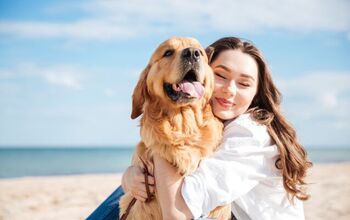How to Perform the Dog Heimlich Maneuver

No owner looks forward to facing emergencies with their pet. Whether it is an injury, an accident, or choking on food, it’s bound to be a lot of stress, for your and your pet. Still, it pays to be prepared for all scenarios. There’s always a possibility something could happen out of the blue, especially related to food and choking, and a diligent owner needs to be prepared for such a situation. Dogs can choke on many things: food, toys, or random objects that look edible. After all, doggos are known to be silly and put everything in their mouth, and often gulp down food voraciously. In case of an emergency, do you know how to perform the dog Heimlich Maneuver?
For many people, if someone near them started choking, they wouldn’t hesitate to take action and administer the Heimlich maneuver. It is one of those classic life-saving performances that everyone knows, at least to a degree. But what do you do when a dog starts choking? The procedure is entirely different, right? There’s a real possibility that it could happen to you at some point of your pooch’s life. There is such a thing as the dog Heimlich maneuver; it just takes a slightly different approach than you would have for a human.
When a dog or cat chokes, it can be a scary situation for any pet parent. Fortunately, if you know the most common choking hazards in pets, then you can get your pet the help she needs and, in some cases, prevent choking all together. Here are five common causes of choking in pets.
What Would Make A Dog Choke?
There are several reasons a dog might choke and need the Heimlich. Here are some of the most common.
Foreign Objects
This is the biggest thing you need to worry about with dogs and choking. They are curious by nature. They like to eat by nature. They find stuff and destroy it, naturally. But dogs accidentally inhaling whatever it is that they’re chewing on can choke. Sometimes these are super tiny toys or their fragments, a piece of trash they found interesting on their walk, or anything in between. A particularly naughty and overly curious doggo might gulp these down with zero hesitation.
And that’s not just things they shouldn’t have. It can be as easy as them inhaling parts of their chews, their bones, their stick…essentially anything smaller than their windpipe or the back of their throat can lodge and choke them. While the dangers of all this are fairly minimal, the possibility still exists.
Supervise chewing, and take chews that are too small away. Never give them rotten and crumbling sticks to chew on, and quickly forbid their snooping into forbidden tiny things.
Collapsing Trachea
This is a common cause in senior small breeds. The Heimlich may not always help because it’s an actual collapse of an organ but if your dog has something lodged in combination, you can still save his life with the procedure.
Constricting Collars
Many owners seem to have trouble finding appropriate and fitting collars, or mistakenly think that collars should be tight. This is wrong. Be careful of constricting collars. This may prevent them from swallowing appropriately, or their airways to be fully open as they eat, and this can cause a problem. Make sure there is enough room for two fingers to slip under their collar to prevent issues. Also be careful with natural leather collars that might shrink in size if they dry out after being wet. All in all, you want to be as careful as possible with your choice of dog collars – they might do more harm than good if not chosen with care.
First Steps to Take with a Choking Dog
If you suspect that your dog is choking, the first thing you need to do is remain calm – becoming hysterical will not help anyone. In fact, dogs can sense what their owners are feeling and if you become worried and upset, your dog will too and that will just make matters worse. The next step is to confirm that he is choking and to attempt to remove the object by hand. If this first step is not possible, then you must proceed to the Heimlich maneuver itself.
Related: Basic First Aid Tips for Dogs
Carefully approach your dog and speak to him slowly in a soothing voice. Even if your dog has never bit anyone in his life, he might snap if he feels threatened or afraid. And in the situation of choking, their fear might be off the charts. Place one hand on top and one hand on the underside of your dog’s muzzle and gently open his mouth – look inside to see if you can see something blocking your dog’s airway. If you see an object, try to remove it by hand, being careful not to let your dog bite you. If you cannot see the object or if you cannot reach it, you may need to administer the Heimlich maneuver on your dog.
Administering the Dog Heimlich Maneuver
Dogs come in all shapes and sizes, and it’s much easier to perform the Heimlich maneuver on a dog that is small enough to lift. Even if your dog is large, however, there is a version of the canine Heimlich maneuver that you can perform:
- Lift the dog up off the ground, pulling him against you with his spine pressed against your chest.
- Wrap your arms around the dog at his waistline. This might feel clumsy or counterproductive at first, but it is important that you do it this way. Even if your pet is wiggling, muster your strength to keep them under control in this position.
- Make a fist with one hand and place it just behind his last rib – wrap your other hand around the fist.
- Push in and up with your hands in 5 quick thrusting motions.
- Open the dog’s mouth to check for the foreign object and remove it, if possible.
- If you cannot remove the object, lift the dog and turn him upside down then sweep your finger into the mouth again to dislodge the object.
- If the object remains stuck, place your dog over your lap (or stand him in front of you) and administer 5 sharp blows with your open hand to the dog’s back between his shoulder blades. This should hopefully dislodge the object allowing the passage of air.
- Open the dog’s mouth and check again for the object – remove it by hand, if possible.
- Repeat this procedure until the object becomes dislodged or your dog falls unconscious.
- If your dog falls unconscious, administer 5 rescue breaths and repeat the 5 abdominal thrusts, continuing the pattern until the object is dislodged.
If your dog is too heavy for you to lift off the ground, you may need to change your tactics slightly. Place your dog in a standing position after checking for the obstruction and wrap your hands around his body just behind the rib cage. Make a fist with one hand and wrap the other around it then administer the 5 abdominal thrusts mentioned in Step 4. If you this doesn’t work, lift the dog’s back legs so his head hangs toward the ground and try again to remove the object. The rest of the steps can be administered as listed above until your dog’s airway is cleared.
When your dog is choking, every second counts so it is important that you know what to do in this situation. You must remain calm but take action quickly to clear your dog’s airway and to restore his breathing. After you’ve cleared the obstruction and your dog has resumed breathing, take him to the vet to make sure he hasn’t suffered any complications. Be cool, be composed, and be brave. Your pet depends on your help, and you can offer it only if you are ready to act.
Remember that panic can be a dangerous thing in these situations. Often enough, it is panic that actually causes a bad outcome. It clouds your senses, wasting those precious moments you could be spending on actually saving your pet. So don’t be overcome by this sensation. Instead, remain calm and rational, and quickly recognize what is happening. Going off the rails about it won’t help at all. Instead, approach the situation with a cool and composed mind and you would be surprised how quickly all the things you learned will float to the surface.
And with all that, it is certain that you will have much greater chances at actually helping your pet and saving their life. Don’t skimp over these important rules, believing that it can never happen to your pet and you. It costs nothing to familiarize yourself with this technique as properly as you can, and to always be prepared in case of your pet choking.

Kate Barrington is the loving owner of two cats (Bagel and Munchkin) and a noisy herd of guinea pigs. Having grown up with golden retrievers, Kate has a great deal of experience with dogs but labels herself a lover of all pets. Having received a Bachelor's degree in English, Kate has combined her love for pets and her passion for writing to create her own freelance writing business, specializing in the pet niche.
More by Kate Barrington























